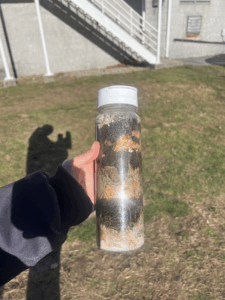 Why would anyone want to make lasagna out of waste? To help pollinators, of course! On November 4, I had the pleasure of implementing my first project as an AmeriCorps individual placement with the Friends of Mashpee National Wildlife Refuge. Lucinda Keith, Glenn Davis, MaryKay Fox, and I gathered at KC Coombs School to install two “lasagna” pollinator gardens. Unlike its namesake, a “lasagna” garden does not include pasta, cheese, and tomato sauce but rather natural waste products that can be utilized to promote plant growth! After assembling the metal raised beds, we arranged cardboard, grass clippings, toilet rolls, crushed quahog shells, fallen maple leaves, coffee grounds, and compost into layers, similarly to how one would layer the ingredients of a lasagna. These materials will decompose over the winter so that fertile soil is created by spring, when pollinator friendly species will be planted! Throughout the installation process, I had the pleasure of educating the students of Ms. Vincent’s K-2 STEAM classes on the steps to creating a “lasagna” garden and the importance of creating pollinator habitats on Cape Cod.
Why would anyone want to make lasagna out of waste? To help pollinators, of course! On November 4, I had the pleasure of implementing my first project as an AmeriCorps individual placement with the Friends of Mashpee National Wildlife Refuge. Lucinda Keith, Glenn Davis, MaryKay Fox, and I gathered at KC Coombs School to install two “lasagna” pollinator gardens. Unlike its namesake, a “lasagna” garden does not include pasta, cheese, and tomato sauce but rather natural waste products that can be utilized to promote plant growth! After assembling the metal raised beds, we arranged cardboard, grass clippings, toilet rolls, crushed quahog shells, fallen maple leaves, coffee grounds, and compost into layers, similarly to how one would layer the ingredients of a lasagna. These materials will decompose over the winter so that fertile soil is created by spring, when pollinator friendly species will be planted! Throughout the installation process, I had the pleasure of educating the students of Ms. Vincent’s K-2 STEAM classes on the steps to creating a “lasagna” garden and the importance of creating pollinator habitats on Cape Cod.
 Pollinators, such as butterflies, bees, bats, and hummingbirds, move pollen from one plant to another, resulting in the successful reproduction of the plant species. Tree, flower, and agricultural crop populations would decline and eventually disappear without this process. Similarly, pollinators often rely on specific plant species to reproduce, such as the monarch butterfly’s reliance on milkweed to lay eggs. As natural lands become less abundant in the United States, pollinators are struggling to find sanctuary in areas that have the right plant species without the presence of toxic pesticides. By having pollinator gardens on the KC Coombs School campus, we are creating a critical refuge for pollinators on Cape Cod. However, the installation of the raised beds was just the beginning. In the spring, students may have the opportunity to help myself and my service partners to plant seeds, remove weeds, and observe pollinators in action! Additionally, I will be creating a Gilbert the Goldfinch Gardening Guide so that students, teachers, and parents can learn from our American Goldfinch friend how to create and maintain pollinator gardens in school and at home! I would like to give a huge thank you to my service partners, Ms. Vincent, KC Coombs School, and all those who donated materials. This project would not be possible without your support!
Pollinators, such as butterflies, bees, bats, and hummingbirds, move pollen from one plant to another, resulting in the successful reproduction of the plant species. Tree, flower, and agricultural crop populations would decline and eventually disappear without this process. Similarly, pollinators often rely on specific plant species to reproduce, such as the monarch butterfly’s reliance on milkweed to lay eggs. As natural lands become less abundant in the United States, pollinators are struggling to find sanctuary in areas that have the right plant species without the presence of toxic pesticides. By having pollinator gardens on the KC Coombs School campus, we are creating a critical refuge for pollinators on Cape Cod. However, the installation of the raised beds was just the beginning. In the spring, students may have the opportunity to help myself and my service partners to plant seeds, remove weeds, and observe pollinators in action! Additionally, I will be creating a Gilbert the Goldfinch Gardening Guide so that students, teachers, and parents can learn from our American Goldfinch friend how to create and maintain pollinator gardens in school and at home! I would like to give a huge thank you to my service partners, Ms. Vincent, KC Coombs School, and all those who donated materials. This project would not be possible without your support!
